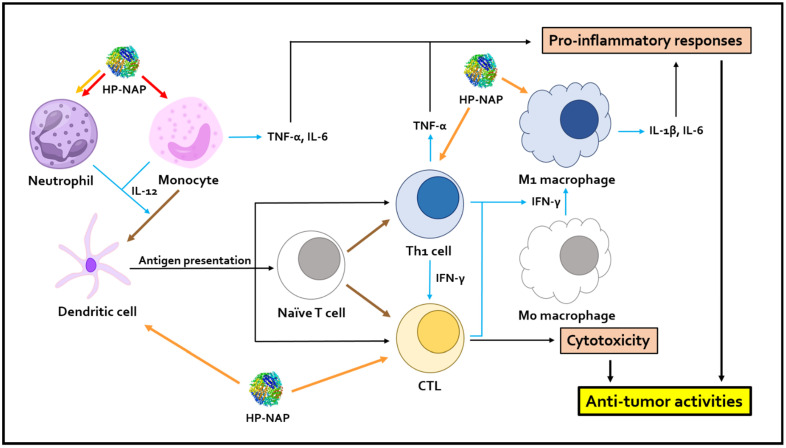Figure 3.
Schematic presentation of how HP-NAP promotes anti-tumor immune responses by inducing pro-inflammatory responses and CTL activity. HP-NAP directly activates neutrophils and monocytes to induce the secretion of IL-12. Activated monocytes also secrete TNF-α and IL-6 to promote anti-tumor inflammatory responses. The release of IL-12 could promote the differentiation of monocytes into dendritic cells (DCs). Mature dendritic cells promote the differentiation of naïve T cells into Th1 cells by antigen presentation, and further lead to the release of Th1 cytokines, such as IFN-γ and TNF-α, from Th1 cells. The polarization of M1 macrophages could be promoted by IFN-γ. M1 macrophages secrete IL-1β and IL-6 into tumor microenvironments and enhance inflammation responses. Antigen presentation, mediated by DCs, and Th1 cytokines could promote the differentiation and activation of CTLs to mediate anti-tumor immunity. HP-NAP also induces the infiltration of neutrophils, M1 macrophages, antigen-presenting DCs, Th1 cells, and CTLs into tumor microenvironments. “↓” indicates induction; red arrows indicate the direct stimulation of the cells by HP-NAP; orange arrows indicate the stimulation of cell infiltration by HP-NAP; blue arrows indicate stimulation of cellular activity; brown arrows indicate differentiation. HP-NAP, H. pylori neutrophil-activating protein; Th1, T-helper type 1; CTL, cytotoxic T lymphocyte; IL-1β, interleukin-1β; IL-6, interleukin-6; IL-12, interleukin-12; IFN-γ, interferon-γ; TNF-α, tumor necrosis factor-α.

